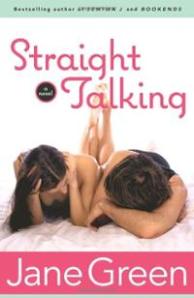Chick Lit is a term used to describe a genre that originated in the 1990’s, which is written by women for women and centers on their everyday lives, their struggles, essentially the issues they face at work, with their family and friends, and in their search of love. The genre began with such publications as Helen Fielding’s Bridget Jones’s Diary in 1996, as well as Candace Bushnell’s Sex and the City in novel form. Jane Green, a British, now US based, author is one of the founding members of this genre; her first novel, Straight Talking, was published in 1997. Since then she has published numerous bestsellers on both sides of the Atlantic.
Here is the first UK edition of the novel from 1997:
As you can see this cover is vastly different from those that Chick Lit readers are used to these days (why a leopard cover? Very un-appealing, no froth, or frills, and least of all fun). The reason may be, as with Lad Lit, that there was no formula in place by then that could dictate a certain look which could guarantee a receptive audience – after all a new genre must be introduced to its readership before readers are able to recognize the books that belong to it. Lastly it can take trial and error until one of these books becomes a bestseller, at which point publishers have a successful cover to imitate in the hopes of achieving similar results.
This is how the novel looked when it was re-issued in 2003:
Frankly, I like this cover even worse than the original, mostly because I don’t feel it says anything about the novel. The wholesome, clean look reminds me, for some reason, of maternity books (most of the time they have a white cover, to indicate health perhaps?). I feel like this book would give me some kind of clinical advice at least.
2003 was also the year that Straight talking was released in the US (although it was Green’s first book it was not the first of her books to be published in the US) and we finally start seeing the Chick Lit “signature look”. These covers are from 2002 and 2003:
Here he have the flowery font, the beige colour, the silhouette drawings that, I believe, enable readers to imagine the characters’ appearance in any way they want (making it easier for each reader to identify with the protagonist). These covers are romantic, dreamy, and the reader knows what she is getting when buying this book.
Even though there is a development from the earlier covers to the recent ones who bear what has now become a “traditional” Chick Lit cover, the digital environment does not, in general, seem to have had much influence on the cover art. It seems that it is not prudent to deviate too much from this known Chick Lit look, not even to help with online sales. If you take a look at this list you may see a slight change, the font may be bigger (Green’s name is more prominent), the colour palette more often than not belonging to the pastel family (making the font easier to read) but the typeface, the flowery, dreamy text stays the same. These books are intended for a certain audience and the readers must be able to pick them out easily, which seems to be more important than how the covers look online (though one could argue that need not be mutually exclusive).
It is possible to get Straight Talking from eBookDownloads with this very simple cover:
However, when I look at this cover I don’t see a Chick Lit novel. Maybe that works for people who don’t care about covers at all. But I believe it is possible to make a cover that looks like a Chick Lit novel and is easy to view as a thumbnail and on digital devices. If I had to choose, I would pick the Chick Lit-y, difficult-to-read-the-font-on-Amazon cover over this one any day.




